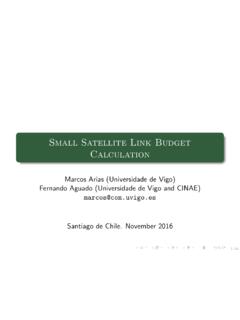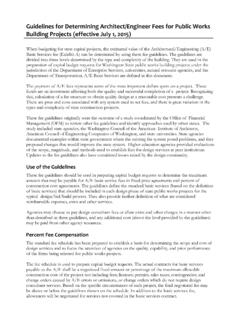Transcription of LINK BUDGET CALCULATIONS FOR A SATELLITE LINK WITH …
1 2019 Kymeta Corporation and its affiliates. KYMETA, CONNECTED BY KYMETA, MTENNA, K LO image, and K LO are trademarks of Kymeta Corporation, with registrations or pending applications for these marks in Brazil, the European Union, Japan, Norway, Singapore, South Korea, and the United States. All other trademarks are the property of their respective BUDGET CALCULATIONS FOR A SATELLITE link WITH AN ELECTRONICALLY STEERABLE ANTENNA TERMINAL1 JUNE 2019793-00004-000-REV01 2019 Kymeta Corporation and its affiliates. KYMETA, CONNECTED BY KYMETA, MTENNA, K LO image, and K LO are trademarks of Kymeta Corporation, with registrations or pending applications for these marks in Brazil, the European Union, Japan, Norway, Singapore, South Korea, and the United States. All other trademarks are the property of their respective owners. 1 Introduction.
2 1 2 The ESA compared to the parabolic dish ..1 3 The three types of link budgets ..3 FWD link : hub to terminal ..4 Simple RTN link : terminal to SATELLITE ..4 Complex RTN link : terminal to SATELLITE and SATELLITE to hub ..4 4 link components and their parameters ..5 Terminal ..5 Antenna scan angle and cosine Gain, noise temperature, and G/T ..6 Terminal Noise Temperature ..6 EIRP and EIRP density ..8 Transmission medium ..8 Free-Space Path Loss (FSPL) ..9 Atmospheric loss ..10 Rain fade and availability ..11 SATELLITE ..13 Transponder EIRP ..13 Saturation Flux Density (SFD), HPA back-off, and SATELLITE G/T ..14 Additional Factors Affecting ..15 Hub ..15 G/T.
3 15 5 Calculating SNR ..16 FWD equation ..16 Simple RTN equation ..16 Complex RTN equation ..17 If SATELLITE and hub parameters are not available ..17 6 Converting SNR to spectral efficiency and throughput ..17 MODCOD ..18 Spectral efficiency (SE) ..18 Throughput (data rate) ..19 7 Example link BUDGET SNR CALCULATIONS ..20 FWD link ..20 Simple RTN link ..21 Complex RTN link ..21 8 Conclusion ..22 9 References ..23 TABLE OF CONTENTS1 2019 Kymeta Corporation and its affiliates. KYMETA, CONNECTED BY KYMETA, MTENNA, K LO image, and K LO are trademarks of Kymeta Corporation, with registrations or pending applications for these marks in Brazil, the European Union, Japan, Norway, Singapore, South Korea, and the United States. All other trademarks are the property of their respective | INTRODUCTIONWhen designing a telecommunications system, one of the first and most important steps is to calculate a link BUDGET (also called a link analysis).
4 The link BUDGET is a theoretical calculation of the end-to-end performance of the communications link . It accounts for all the gains and losses of the link under a specific set of conditions, and the result of the analysis is a set of figures of merit that characterizes the quality of the link . The most common figures of merit are: SNR (signal-to-noise ratio) Spectral efficiency (bits per second/Hz) Throughput (bits per second)This paper shows you how to calculate the link BUDGET for a SATELLITE link that uses a flat panel, electronically steerable antenna (ESA) at the user terminal in mobility and fixed configurations. Before performing some example CALCULATIONS , we ll first look briefly at the differences between a traditional parabolic dish antenna and an ESA, define three basic types of link budgets, and then identify the basic components of a SATELLITE link and their associated gains and losses.
5 2 | THE ESA COMPARED TO THE PARABOLIC DISHThe conventional method of communicating with a geostationary SATELLITE uses a parabolic dish antenna, which consists of a feed system and a passive parabolic reflector (Figure 1). The feed antenna is positioned in front of the reflector and illuminates it with radiation. The parabolic shape of the reflector ensures that the paths of the radiation from the feed antenna to the reflector and outwards from the reflector are all the same length, so that they combine in phase to produce a plane wave. Also, the paths from the reflector outward are all in parallel. The result is an accurate, highly directional beam. The directivity of the dish antenna also applies to incoming signals, greatly reducing the received power of signals coming from satellites or other sources that the antenna is not pointed combination of high directivity and high radiation efficiency results in a high gain for the dish antenna.
6 The gain can be further increased by increasing the size of the stationary installations, the dish antenna can be set up, pointed at the SATELLITE , and calibrated just once. But if used in mobility applications, such as on a vehicle, it must be repositioned whenever the vehicle moves to keep it pointed at the SATELLITE . This requires a motorized mount, which adds bulk FIGURE 1. PARABOLIC DISH ANTENNA2 2019 Kymeta Corporation and its affiliates. KYMETA, CONNECTED BY KYMETA, MTENNA, K LO image, and K LO are trademarks of Kymeta Corporation, with registrations or pending applications for these marks in Brazil, the European Union, Japan, Norway, Singapore, South Korea, and the United States. All other trademarks are the property of their respective weight, often making the dish antenna slow and cumbersome, or simply impractical for use, especially on smaller vehicles.
7 The costs of manufacturing an accurate paraboloid reflector and a stable, precise gimbal mount can be high. Furthermore, the mount is subject to wear and mechanical failure from movement and from dirt intrusion. Flat panel antennas that electronically steer (scan) their beams to track satellites are an increasingly popular alternative to dish antennas (Figure 2). Although there are various technologies in use, most ESAs use electronic control of the relative phase of the signals emitted from up to thousands of small antenna elements in a planar array to produce constructive and destructive interference, forming a beam that can be steered to track a SATELLITE much more quickly than mechanical they have no external feed antenna or moving parts, ESAs can have a low profile of only a few inches and a relatively low weight. They can be simply mounted on the roof or other external surface of a vehicle (Figure 3).
8 The accuracy and speed of electronic beam steering means that ESAs, in comparison with dish antennas, can more easily stay connected to a SATELLITE while the vehicle is moving. They can also be more easily sealed against weather and contamination than dish antenna assemblies. These advantages make them ideal for use on mobile platforms of almost any size, including buses, first responder vehicles, cars, construction vehicles, airplanes, and ships. Also, an ESA-based SATELLITE terminal can be built into a rugged, transportable case for quick setup and use anywhere there is SATELLITE coverage. The main disadvantages of ESAs compared to dish antennas are lower gain, and the variation in gain as the location and orientation are changed. For example, at high latitudes under geostationary satellites, a horizontal ESA will have less aperture area facing the SATELLITE , resulting in lower efficiency than a dish, which can be mechanically pointed at the SATELLITE for maximum gain.
9 However, as non-geostationary LEO (Low Earth Orbit) and MEO (Medium Earth Orbit) SATELLITE constellations become available, this problem will diminish, since the satellites are moving, so that there will always be a SATELLITE overhead. Even with a fixed terminal, an ESA will have an advantage over a dish when using non-geostationary satellites, since it can track them without a gimballed tracking pedestal. FIGURE 2. ELECTRONICALLY SCANNED ANTENNA (KYMETA)FIGURE 3. ESA MOUNTED ON THE ROOF OF A COMPACT SUV3 2019 Kymeta Corporation and its affiliates. KYMETA, CONNECTED BY KYMETA, MTENNA, K LO image, and K LO are trademarks of Kymeta Corporation, with registrations or pending applications for these marks in Brazil, the European Union, Japan, Norway, Singapore, South Korea, and the United States. All other trademarks are the property of their respective | THE THREE TYPES OF link BUDGETSS atellite links are named according to the flow of information on them.
10 On the forward (FWD) link , information flows from the hub (earth station) to the user terminal. On the return (RTN) link , information flows from the user to the hub. Figure 4 shows the hub, SATELLITE , and user terminal and the direction of data flow for the FWD and RTN paths. The FWD link BUDGET is usually easiest to calculate, since good assumptions can be made to simplify the CALCULATIONS . For example, the output power of the SATELLITE can be assumed to be constant for the downlink to the terminal, since the hub has sufficient power to keep the SATELLITE s high power amplifiers (HPAs) operating at saturation (or at the maximum power set by the operator). However, with a small aperture antenna such as an ESA, the uplink power from the terminal received by the SATELLITE varies with antenna orientation and is not typically high enough to drive the HPAs to saturation, resulting in variable output power from the SATELLITE .







